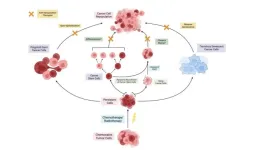(Press-News.org) BIRMINGHAM, Ala. – Stress during adolescence can cause postpartum behavioral changes in women and other mammals, including depression and changes in social behavior after the birth of a child.
However, the neural circuit mechanisms by which adolescent stress leads to later changes in postpartum social behavior are unclear. In a Nature Communications study, University of Alabama at Birmingham researcher Minae Niwa, Ph.D., used a mouse model and cutting-edge neurobiological techniques to show how psychological stress during adolescence alters neuronal functions in the brain, resulting in altered postpartum social behavior.
This research builds on her recent finding that mice exposed to social isolation in late adolescence, which alone causes no endocrine or behavioral changes, show long-lasting behavioral changes only when accompanied by pregnancy and delivery. Niwa and colleagues were able to use this behavioral model to probe for postpartum neural circuit differences between mouse dams that were stressed in late adolescence and a control group of mouse dams that remained unstressed in adolescence, due to normal social interactions with other mice.
Niwa focused on the prelimbic cortex, a hub region of the brain that plays a crucial role in social behavior and regulation of stress responses. The UAB researchers used optogenetics — where light signals can selectively activate or inhibit brain circuits — and in vivo calcium imaging, which allows researchers to examine neuronal activity of specific neurons in a brain region. These approaches allow investigators to understand how nerve cells communicate in freely-behaving animals.
The UAB Department of Psychiatry and Behavioral Neurobiology researchers found that adolescent psychosocial stress, combined with pregnancy and delivery, caused hypofunction of the glutamatergic pathway that they mapped from the anterior insula region of the brain cortex to the prelimbic cortex. Glutamate is the main excitatory neurotransmitter in the central nervous systems of mammals.
The diminished function of this cortico-cortical pathway altered neuronal activity in the prelimbic cortex and led, in turn, to abnormal social behavior, as seen in a test of how much time a mouse dam spends with a familiar mouse that is confined in one corner of a cage, versus a novel mouse, confined in another corner. In this social novelty trial, the unstressed dams — in contrast to stressed dams — spent more interaction time per visit and more total interaction time with the novel mouse.
Specifically, Niwa and colleagues found that the anterior insula-prelimbic cortex pathway played a crucial role during recognizing the novelty of other mice by modulating what they call “stable neurons” in the prelimbic cortex, which were constantly activated or inhibited by novel mice. A cortico-cortical pathway means that action potential from a neuron in one area of the brain cortex travels to target neurons in another cortical area.
In their first experiments, the UAB researchers found that decreased activity in the anterior insula-prelimbic cortex pathway correlated with reduced preference for social novelty in stressed dams. They then used optogenetics to confirm the functional relevance of this pathway.
Notably, in social novelty trials optogenetic inhibition of the anterior insula-prelimbic pathway in unstressed dams reduced social interaction with novel mice, making their social behavior more like stressed dams. In contrast, optogenetic activation of the anterior insula-prelimbic pathway in stressed dams ameliorated behavioral changes seen in the social novelty trial, making them act more like unstressed dams.
Furthermore, the UAB team was able to restrict the timing of optogenetic modulation in the social novelty trials, so it occurred only during mouse exploration of its cage or only during interaction with the novel or familiar mice that were constrained in two corners of the cage. Results showed that the anterior insula-prelimbic cortex pathway that modulates the stable neurons in the prelimbic cortex plays a crucial role only during social novelty interactions with other mice, rather than during exploration.
Additionally, they revealed the involvement of a stress-hormone receptor called glucocorticoid receptor, or GR, in the anterior insula-prelimbic pathway. By selectively removing the GR in this pathway, they observed a restoration of the changes in neuronal activity in the prelimbic cortex of stressed dams. “These findings suggest that the prolonged elevation of the stress hormone during the postpartum period plays a crucial role in the observed alterations in neuronal pathway and social behavior,” Niwa said.
“Our study has revealed significant findings that demonstrate the involvement of the anterior insula-prelimbic pathway in adolescent stress-induced postpartum alterations related to the recognition of the novelty of other mice, which is a key aspect of social behavior,” she said. “Exploring upstream and downstream contributions of the anterior insula-prelimbic pathway would facilitate our understanding of the postpartum social behavioral changes that are induced by social isolation in late adolescence, as well as our understanding of the nature of social behavior.”
Co-authors with Niwa in the study, “Adolescent stress impairs postpartum social behavior via anterior insula-prelimbic pathway in mice,” are Kyohei Kin, Jose Francis-Oliveira and Shin-ichi Kano. All are in the UAB Department of Psychiatry and Behavioral Neurobiology, where Niwa is an associate professor. Psychiatry and Behavioral Neurobiology is a department in the Marnix E. Heersink School of Medicine.
Support came from National Institutes of Health grants MH116869 and MH128708; UAB Psychiatry and Behavioral Neurobiology startup funds; and the Takeda Science Foundation Fellowship Program for Young Japanese M.D.s and Ph.D.s Studying Abroad.
END
Brain pathway identified that impairs postpartum social behavior after adolescent stress
Researchers used a mouse model and cutting-edge neurobiological techniques to show how psychological stress during adolescence alters neuronal functions in the brain, resulting in altered postpartum social behavior
2023-06-23
ELSE PRESS RELEASES FROM THIS DATE:
People are falsely denying firearm ownership, and it’s not who you might think
2023-06-23
Some firearm owners may not want researchers to know they own firearms, according to a study by the New Jersey Gun Violence Research Center at Rutgers.
In a study published in Social Psychiatry and Psychiatric Epidemiology, researchers found that based on their answers to a variety of other questions, a group of individuals appeared as though they might be falsely denying firearm ownership when directly asked by researchers.
While some of these individuals resemble what previous research indicated to be a typical American firearm owner (e.g., white, male), others looked quite different (racial or ethnic minority, female, ...
Source of common kidney disease lies outside the kidney, study suggests
2023-06-23
NEW YORK, NY--The cause of a common kidney disease likely lies outside the kidney, according to a new study led by Columbia University researchers. The study, which uncovered 16 new locations in the genome linked to immunoglobulin A (IgA) nephropathy, confirms an earlier hypothesis that the immune system has an important role in driving the disease and points toward new strategies for detecting and treating it.
No targeted treatments have been approved to treat IgA nephropathy, largely because the underlying cause of the disease has not been well understood.
Identifying genes linked ...
Stanford Medicine-led research identifies a subtype of depression
2023-06-23
Scientists at Stanford Medicine conducted a study describing a new category of depression — labeled the cognitive biotype — which accounts for 27% of depressed patients and is not effectively treated by commonly prescribed antidepressants.
Cognitive tasks showed that these patients have difficulty with the ability to plan ahead, display self-control, sustain focus despite distractions and suppress inappropriate behavior; imaging showed decreased activity in two brain regions responsible for those tasks.
Because depression has traditionally been defined as a mood disorder, ...
Stanford University’s Innovative Medicines Accelerator and Intonation Research Laboratories form a collaboration to fight cancerous neuroendocrine tumors
2023-06-23
Stanford University’s Innovative Medicines Accelerator (IMA) and Intonation Research Laboratories (Intonation) have formed a collaboration to develop treatments that target cancerous neuroendocrine tumors, or tumors that form from hormone-releasing cells.
The goal of the collaboration is to reduce the time and resources it takes to translate a biomedical breakthrough into a clinically and commercially viable medicine.
“I’m excited about this collaboration with Intonation Research Laboratories, which has the potential to speed ...
Extinct warbler’s genome sequenced from museum specimens
2023-06-23
The Bachman’s warbler, a songbird that was last seen in North America nearly 40 years ago, was a distinct species and not a hybrid of its two living sister species, according a new study in which the full genomes of seven museum specimens of the bird were sequenced. Genome comparisons of Bachman’s warbler with the golden-winged and blue-winged warblers also helped researchers identify a new candidate gene involved in feather pigmentation in the group. A paper describing the study, led by Penn State researchers, highlights the crucial role that museum collections can play in science and appears ...
Baylor researchers examine relationship between imprisoned mothers and their adolescent children’s risk behaviors
2023-06-23
WACO, Texas (June 23, 2023) – Women represent the fastest-growing population in U.S. institutional corrections facilities. In the past four decades, the number of women incarcerated has increased by more than 475%, rising from 26,326 in 1980 to 152,854 in 2020.Because the majority of imprisoned women are mothers, a conservative estimate indicates that at least one million American children have experienced maternal incarceration, and a substantial portion of them are adolescents.
Evidence suggests that maternal incarceration is a risk factor for adolescents’ ...
NSF CAREER Awardee develops a 1-minute frailty testing platform
2023-06-23
A layperson might think of “frail” as simply a synonym for “weak” or “fragile.” But in the medical field, frailty is a specific term, meaning – due to factors including inflammation and hormone shifts – a patient has a lack of physiological reserve, or a reduced ability to tolerate stress.
“That stress can be anything from the simple event of falling to getting COVID or another infectious disease,” said Nima Toosizadeh, assistant professor of biomedical engineering and medicine. “Or, it can be a treatment that might be invasive for patients. Knowing who can tolerate the stress is critical.”
It ...
Cancer cell repopulation after therapy: which is the mechanism?
2023-06-23
“Approaches targeted to prevent this post-therapy cancer cell repopulation should be uncovered to prevent tumor relapse and thus increase overall survival from this devastating disease.”
BUFFALO, NY- June 23, 2023 – A new research perspective was published in Oncoscience (Volume 10) on June 1, 2023, entitled, “Cancer cell repopulation after therapy: which is the mechanism?”
The past two decades have brought great progress in the treatment of cancer as patients with the disease live ...
Mario Romero-Ortega to lead Biomedical Engineering at the University of Arizona
2023-06-23
Mario Romero-Ortega was selected through a nationwide search to head the University of Arizona Department of Biomedical Engineering, beginning with the fall 2023 semester.
“I was drawn by the culture of collaboration, the quality of the students and faculty, and by the unified vision from University of Arizona leadership to impact biomedical engineering and health, from local to global,” he said.
Romero-Ortega will join the College of Engineering from the University of Houston, where he serves in the College of Engineering as a Cullen ...
When majority men respect minority women, groups communicate better
2023-06-23
Kyle Emich, a professor of management at the Alfred Lerner College of Business and Economics, along with Rachel Amey and Chad Forbes, then with UD’s Psychology and Brain Sciences Department, were searching for clues about why women’s knowledge often gets ignored in the workplace and how to improve the situation.
Drawing on both a problem-solving group exercise and measurements of brain activity, their findings, now published by the journal Small Group Research, illustrate ways stereotypes and attitudes can ...
LAST 30 PRESS RELEASES:
Membrane magic: FAMU-FSU researchers repurpose fuel cells membranes for new applications
UN Member States pledge to increase access to diagnosis and inhaled medicines for the 480 million people living with COPD
Combination therapy shows potential to treat pediatric brain cancer ATRT
Study links seabird nesting to shark turf wars in Hawai‘i
Legal sports betting linked to sharp increases in violent crime, study finds
Breakthrough AI from NYUAD speeds up discovery of life-supporting microbes
New Eva Mayr-Stihl Foundation funding initiative boosts research at University of Freiburg on adaptation of forests to global change
The perfect plastic? Plant-based, fully saltwater degradable, zero microplastics
Bias in data may be blocking AI’s potential to combat antibiotic resistance
Article-level metrics would provide more recognition to most researchers than journal-level metrics
Satiety’s little helper: Protein that supports appetite regulating protein identified
UF dives deep into predicting storm damage with computer models
A stormy ocean voyage yields insights on the global carbon cycle
Scientists identify first non-coding gene that controls cell size
Demonstration of altermagnetism in RuO₂ thin films -- A new magnetic material for the AI era
Penn researchers awarded $25M to conduct trial using smartphones to fight heart disease
PCORI awards funding for new patient-centered healthcare research
Exploring the origins of the universe: 145 low-noise amplifiers complete ALMA telescopes
Empress cicada wings help illuminate molecular structure
Using sound waves to detect helium
Time burden in patients with metastatic breast and ovarian cancer from clinic and home demands
Researchers discover bias in AI models that analyze pathology samples
Scientists ID potential way to prevent brain injuries from triggering Alzheimer's
MASTER 2nd Open Call: Execution period kick-off
Algae for health in food and pharma
Advanced microrobots driven by acoustic and magnetic fields for biomedical applications
Chicago health information leader recognized for raising CPR readiness and blood pressure awareness
The Intimate Animal, a new book from Kinsey Institute Executive Director Dr. Justin Garcia
When blue-collar workers lose union protection, they try self-employment
New video dataset to advance AI for health care
[Press-News.org] Brain pathway identified that impairs postpartum social behavior after adolescent stressResearchers used a mouse model and cutting-edge neurobiological techniques to show how psychological stress during adolescence alters neuronal functions in the brain, resulting in altered postpartum social behavior




